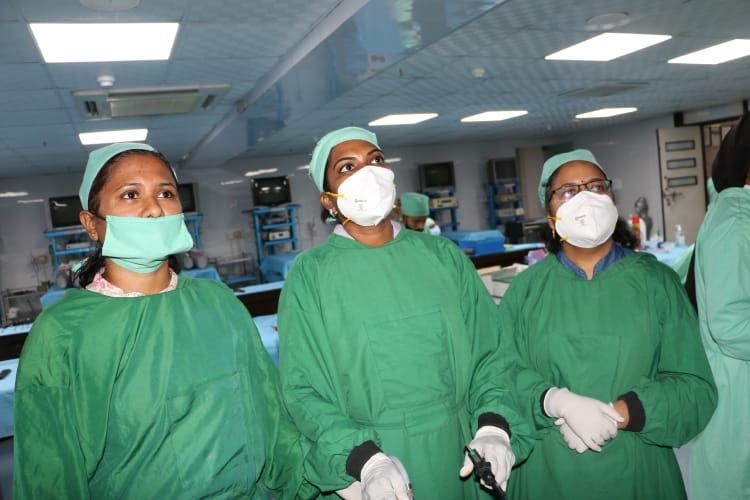Event Date: Wed - 19 Jul, 2023
Event Time: 9:05 am
Location: World Laparoscopy Hospital
Institute: WLH
Hands-on practice using live tissue is a vital component of a gynecologist's training when it comes to advanced laparoscopic procedures like Laparoscopic Burch Colposuspension, Sacrohysteropexy, Pactopexy, Secrocolpopexy, and Cervical Cerclage. These sophisticated surgical techniques play a critical role in the management of various gynecological conditions, and practicing on live tissue offers invaluable learning opportunities for aspiring and experienced gynecologists alike. Laparoscopic Burch Colposuspension: Stress urinary incontinence can significantly impact a woman's quality of life, and Laparoscopic Burch Colposuspension is a precise procedure aimed at providing long-lasting relief. The gynecologist will work with live tissue to identify and manipulate the anatomical structures involved in restoring the support of the urethra and bladder neck. This hands-on training allows the surgeon to develop the necessary skills in handling delicate tissues and suturing techniques, ensuring the correct placement of sutures to support the pelvic structures effectively. Laparoscopic Sacrohysteropexy: Uterine prolapse can cause discomfort and distress for affected women. During hands-on practice on live tissue, the gynecologist learns to skillfully attach the back of the uterus to the sacrum, utilizing specialized mesh or sutures. This procedure requires precision and an understanding of pelvic anatomy, which can be honed through practical experience on live tissue. The training empowers the surgeon to confidently perform Sacrohysteropexy with minimal invasiveness and optimal patient outcomes. Pactopexy (Uterosacral Ligament Suspension): Pactopexy is another technique used to treat uterine prolapse by suspending the uterus to the uterosacral ligaments. This hands-on practice allows the gynecologist to develop proficiency in locating and manipulating the uterosacral ligaments, and understanding the proper tension required to provide adequate support to the uterus. Practical training on live tissue ensures that the surgeon can carry out this procedure safely and effectively when addressing uterine prolapse cases. Sacrocolpopexy: Sacrocolpopexy is a surgical technique used to correct vaginal vault prolapse. During hands-on practice on live tissue, the gynecologist becomes familiar with accessing the vaginal vault, identifying the sacral promontory, and skillfully attaching mesh to support the prolapsed structures. This procedure requires meticulous attention to detail, and live tissue practice offers a realistic and immersive training environment to refine these critical skills. Cervical Cerclage: Cervical cerclage is a preventive procedure performed during pregnancy to reinforce and close the cervix in cases of cervical insufficiency. Hands-on practice on live tissue allows the gynecologist to master the delicate suturing techniques required for cervical cerclage.World Laparoscopy Hospital: A Hub of Contemporary Learning with Daily 8-Hour Hands-On Laparoscopic Training
In the realm of medical education and training, there are institutions that stand out as pioneers, constantly pushing the boundaries of what is possible. One such institution is the World Laparoscopy Hospital, where a contemporary event unfolds every day, featuring a remarkable 8-hour hands-on laparoscopic training program.
A Daily Revolution in Learning
At the heart of the World Laparoscopy Hospital's mission is the commitment to train the next generation of surgeons and medical professionals in the art and science of Minimal Access Surgery. What makes this institution truly exceptional is its daily 8-hour hands-on laparoscopic training program.
The Laparoscopic Revolution
Laparoscopic surgery, often referred to as minimally invasive surgery, has revolutionized the field of surgery in recent decades. Instead of large incisions, this technique involves making tiny keyhole-like openings through which a camera and surgical instruments are inserted. This results in significantly reduced patient trauma, shorter recovery times, and less post-operative pain.
The Daily Experience at World Laparoscopy Hospital
Every day at World Laparoscopy Hospital is a contemporary event in the world of medical education. Here's a glimpse into what a typical day looks like for those fortunate enough to train at this prestigious institution:
1. Intensive Training: The 8-hour hands-on laparoscopic training is an immersive experience where trainees work side by side with experienced surgeons. This hands-on approach ensures that students gain practical skills and confidence in performing laparoscopic procedures.
2. State-of-the-Art Facilities: The hospital boasts state-of-the-art facilities, equipped with the latest laparoscopic instruments and technology. Trainees have access to the same tools and equipment used in modern surgical practices around the world.
3. Expert Faculty: The training is conducted under the guidance of expert faculty members who are pioneers in the field of Minimal Access Surgery. Their wealth of knowledge and experience provides students with invaluable insights and mentorship.
4. Customized Curriculum: The training program is tailored to the specific needs and experience levels of each student. Whether you are a novice or an experienced surgeon looking to refine your skills, there is a program to suit your requirements.
5. Global Reach: World Laparoscopy Hospital attracts medical professionals from all corners of the world. This diverse group of trainees fosters cross-cultural exchanges and collaborations, enriching the learning experience.
6. Research Opportunities: Beyond the hands-on training, the hospital also serves as a hub for research and innovation in the field of Minimal Access Surgery. Trainees have the opportunity to participate in cutting-edge research projects.
Impact Beyond the Classroom
The impact of the daily 8-hour hands-on laparoscopic training at World Laparoscopy Hospital extends far beyond the classroom. Graduates of this program return to their respective countries armed with advanced skills, contributing to the global dissemination of minimally invasive surgical techniques. Patients around the world benefit from the reduced invasiveness, faster recoveries, and improved outcomes that these skilled professionals bring to their practice.
In conclusion, World Laparoscopy Hospital's commitment to daily 8-hour hands-on laparoscopic training is a testament to its dedication to excellence in medical education. By offering a world-class learning environment and fostering a culture of innovation, this institution is shaping the future of surgery, one trainee at a time. It is not just an institution; it is a beacon of hope for patients and a driving force in advancing the field of surgery.


